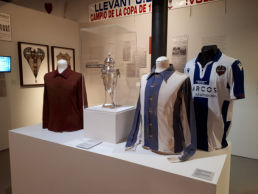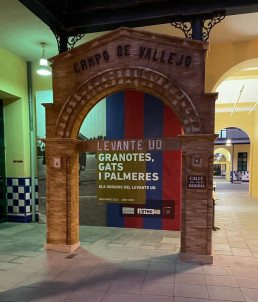The exhibition DE GRANOTES, GATS I PALMERES, els orìgens del Levante at the Museu Valencià d’Etnologia was inaugurated on 22 December 2023 at 19:30. This exhibition was produced by L’ETNO with the collaboration of Levante UD, through the Historical Heritage Department of Levante UD and the Cultural Department of the Diputació de Valencia. This exhibition was curated by José Vicente Aguilar and Asunción García, curators of L’ETNO; and by Emilio Nadal and Borja Arce, members of the Heritage Area of Levante UD, with design by Suso Pérez (Estudio Gimeno Gràfic).
Its launch attracted the attention of all of the different sectors that make up the club’s society. Quico Catalán, president of the Levante board of directors, and Paco Fenollosa, in his capacity as honorary president, represented the governing body of the Orriols institution at an event that was attended by Toni Gaspar, president of the Provincial Council. “In this exhibition, which I encourage everyone to come and visit, I think what we can see is that mutual drive. That Valencia helps Levante to grow and that Levante also helps the city to grow. This is the history of Levante, from which we can also learn from its spirit,” said the head of the Provincial Council. “It is a great gift for a club with so much history and tradition that has contributed so much to the city,” added Quico Catalán, praising the content and magnitude of this event. The Councillor for Culture, Xavier Rius, before the official presentation, emphasised “the great effort of L’ETNO to compile a history of Levante UD that will surprise us with its unpublished material and the intrahistory of the club”.
This exhibition aimed to show the events that have characterised the centenary history of the club. The exhibition offered copious information about the founders of Levante FC and Gimnástico FC, the grounds where both teams played, the format of the old shirts, the titles, the consequences of the Civil War, the merger, the relations between the players and the club…, until reaching the stadium that meant the longed-for transfer to the First Division in the 1962-63 season, when the cat finally climbed the palm tree. The exhibition emphasised the modernity of a pioneering club in its commitment to women’s football and a standard bearer in the consideration of sport as a tool for social inclusion. The exhibition was scheduled to run from the end of December to the month of June, although the favourable response from the public led to an additional extension until 3 September.
The exhibition was organised chronologically in different sections:
Introduction. Sporting Valencia. It shows the sports and manifestations practised by Valencian society before the arrival and popularisation of football. With the improvement of working conditions and the spread of hygienist ideas that advocated sport as a health factor, various sports associated with the different social classes became popular, and their facilities became widespread throughout the city. Some of them still exist today: cycling (velodromes), pelota (pelota courts such as the Jai-Alai, trinquetes, such as the Pelayo), tennis, polo, horse-riding – typical of the wealthy classes – such as the nautical club, or the tennis club.
The origins of Levante U.D. The exhibition shows us the first years of the trajectory of the two teams of the city that, after their merger, would end up forming the current entity. Two teams with different social origins, with different ideological bases, with fields located in distant places and with different sporting trajectories. On the one hand, Levante, founded by a teacher (Vicente Ballester) who organised a team around a school for humble classes, in which sport, in this case football, played on the beach (in Cabanyal) complemented basic education. On the other hand, Gimnástico, which arose from the activity of the Patronato de la Juventud Obrera, the result of the work of integration developed by social Catholicism aimed at the lower strata of society, which over time disassociated itself from the Patronato, losing its more social component in favour of more affluent classes, which turned it into a powerful team with new sports sections such as fencing, athletics and cycling.
War and cup. At the beginning of the Civil War, competitions did not stop and the city’s clubs proclaimed themselves loyal to the Republic. In 1937, the division of the country into two zones prevented the state championships from being played and regional championships were played: the Mediterranean League and the Free Spain Cup. Many matches were also organised in the city of Valencia to pay tribute to and raise funds for the militias, hospitals and charities. Among the tournaments played in that year was the Cup, the final of which was played by Valencia FC and Levante FC, the latter team winning the title. Given that during Franco’s dictatorship this tournament was not recognised, the club and the political authorities, with the support of a large part of the fans and Valencian society, are fighting for this trophy to be recognised for Levante UD.
Merger in 1939. In 1939, at the end of the war, Gimnástico FC and Levante FC suddenly merged. Two teams that had been rivals, with antagonistic social masses, merged with the creation of the Unión Deportiva Levante-Gimnástico. Among the reasons for this merger was the need to bring together two entities that the war had treated unequally, but complementary: Levante had been left without a pitch and with good players and Gimnástico lacked stars, but had a pitch (Vallejo) in good condition. In addition to these conditions, there is also the idea that the merger was intended to form a new football entity in line with the new dictatorship’s guidelines.
Creation of Levante U.D. In 1941, with the same discretion and surprise that had created the UDLG, the team was renamed Levante Unión Deportiva and recovered the blue and maroon of Gimnástico as the team’s colours. The lack of roots of the team born of the merger influenced the decision to return, to a certain extent, to the origins. The new name and colour combination was an explicit recognition of the two teams and the two traditions that formed the team. The premiere took place in a friendly match against Real Madrid.
The rise to the elite. On 2 June 1963, Levante UD made a great dream come true, a dream pursued for decades: promotion to the First Division. After the failed attempts in 1940 and 1959, the cat was able to climb the palm tree. In the promotion promotion play-off they beat Deportivo de La Coruña in Riazor (1-2) and, in the second leg, in Vallejo, they won 2-1. More than 25,000 spectators witnessed this historic milestone. The promotion was a sporting and social event that permeated the life of the whole city of Valencia.



